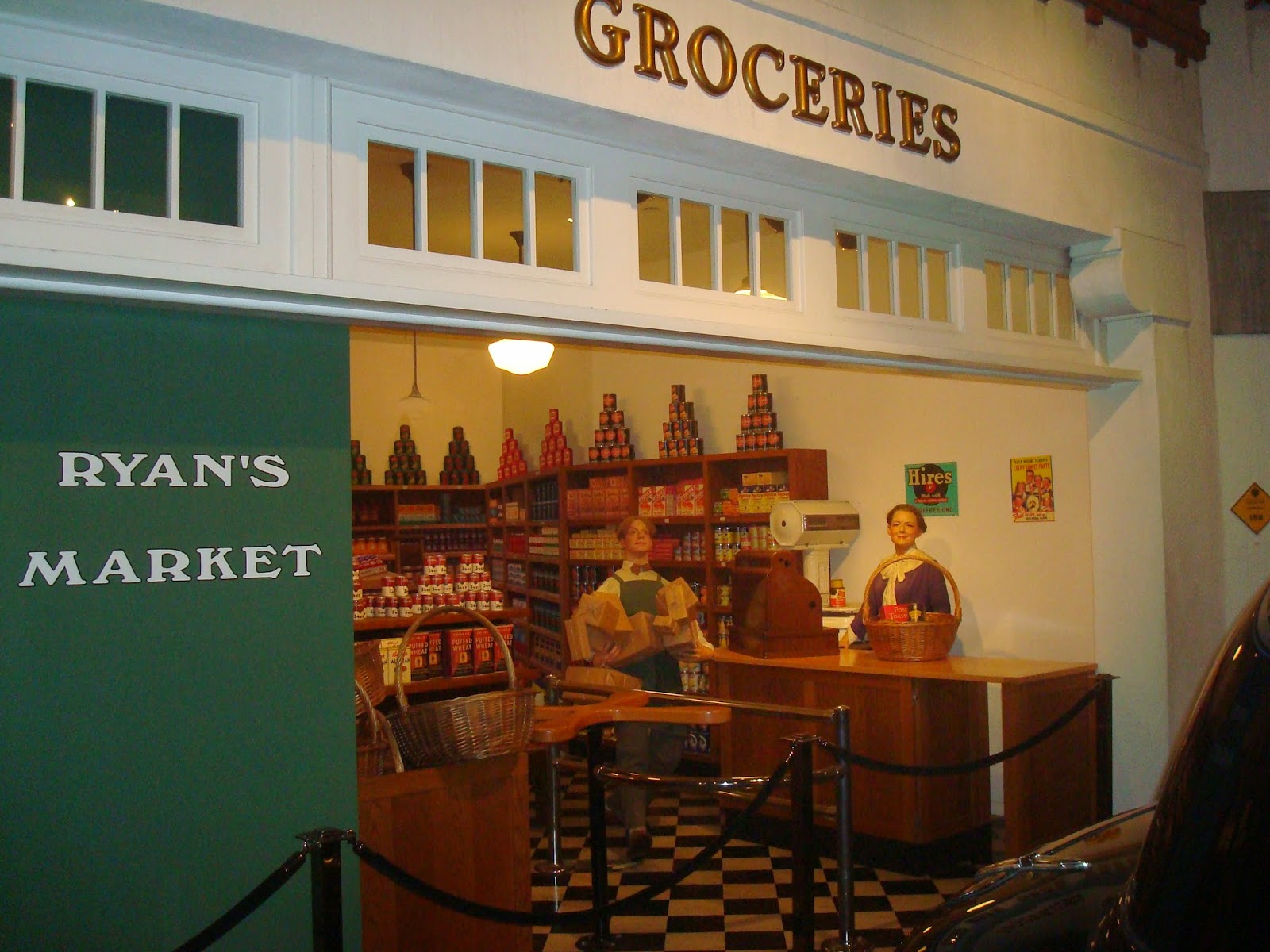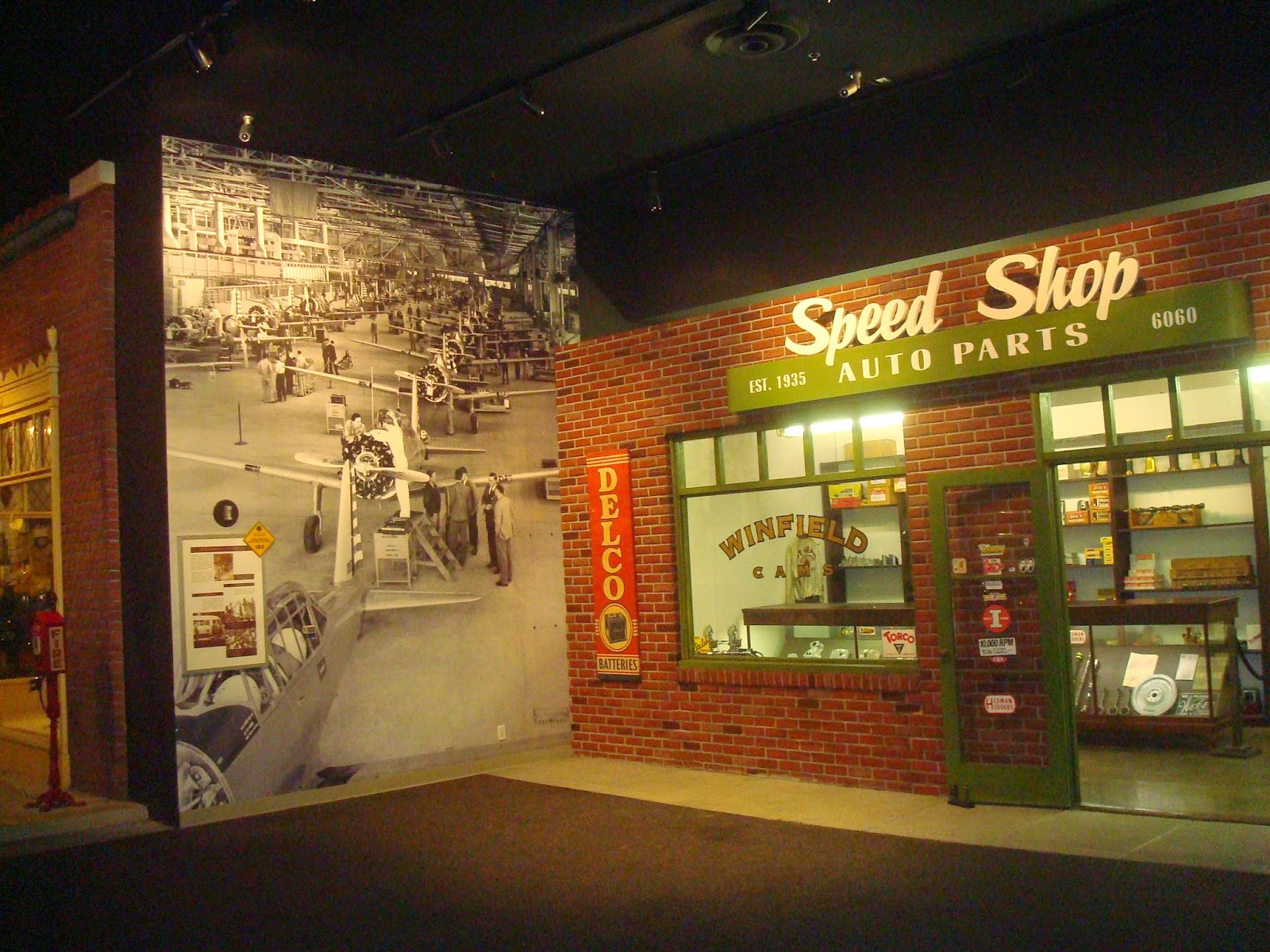October 19th marked the final day the Petersen's doors were open, beginning a temporary closure for its anticipated year-long renovation. Matt Construction is handling the makeover, the same company that oversaw the seismic retrofit and re-design of the Natural History Museum.
The Streetscape Exhibition
This blog post provides a final tour of the Streetscape, along with a look at the tedium in dismantling a museum exhibit. The "street" was set chronologically, so a visitor could stroll a city street from 1900 to the 1950s and learn about early auto manufacturing in L.A.; endurance trips on the open road; cars in movies; consumerism in the auto-age; racing culture; the omnipresent car's influence on restaurant architecture; and the shift from city to suburb in southern California.
 |
| "Stuck in the Mud" showcasing a vehicle from the NHM collection - the 1911 American (Underslung) Touring Traveler |
 |
| Blacksmithing tools include numerous swages in need of wrapping by NHM staff shown here on day one, Oct. 20th |
 |
| Yours truly, the blogger, shown working on an inventory |
 |
| The American Underslung apparently "rescued" from the mud after 20 years |
A blog that has a thorough chronicling of recent Petersen news as well as its old and new architectural features can be found at Blouin Art Info.
I shopped in this building in the early 1970s when it was Ohrbach's Department Store.
Here are some very recent photos of the building in its most unglamorous state.
 |
| Car on side of building |
 |
| Car and all signage has been stripped from the side of the building. Johnny Rockets is going away too. |
 |
| Along Orange Grove Avenue |
 |
| This shot taken a month before the Pete closed up |
Robert Petersen, publisher of magazines including Hot Rod and Motor Trend, convinced the Natural History Museum to create a museum to display NHM's own collection of historic vehicles and motorcycles. (He was a duck hunter and a member of Ducks Unlimited, a group that met at the museum. He probably had other influential ties to NHM.) The early 1990s was an era of expansionism at NHM, as there was a branch museum at the Burbank Mall. An automotive museum sounded logical.
In 1994 the newly-opened Petersen museum began to operate independent of NHM. In the 20 years to follow, the periodic dealings between the Petersen/NHM were about vehicles and other artifacts out on loan.
"Business" storefronts, mannequins and names on the signs were attributed to curators, historians, exhibit designers, administrators, friends and others who were involved with the dioramas of the Streetscape. The names were supposed to be just temporary placeholders as it was intended that sponsors' names would be applied once their contributions were secured. Below, the new car showroom exhibit, Powell Motor Co. was a nod to the then-newly incoming president of the Natural History Museum, James Powell.
 |
| This mannequin in the showroom is the likeness of L.A. County Supervisor, 5th district, Michael Antonovich |
 |
| The fallen suede pump of a woman mannequin in the showroom |
 |
| The showroom becomes the main packing area for NHM staff |
 |
| The Breer Blacksmith Shop, an homage to Carl Breer, early carmaker. On display is his made-in-LA 1901 steam car - on loan from the Natural History Museum |
 |
| The alley next to the Blacksmith Shop - with NHM's circa 1900 motorized wagon that possibly was constructed in Riverside |
 |
| A closer look at the Breer car |
 |
| The streetcar |
 |
| A packing scene |
 |
| Earl Cooper's Stutz White Squadron Race Car- the car was a donation by Cooper to the NHM collection |
 |
| The oil-stained wooden track on which the Stutz sat has been pulled out of display |
 |
 |
| Laurel and Hardy - based on a movie still photograph at the Natural History Museum |
 |
| The CHP officer was modeled after Joe Cocke, who worked in NHM's Exhibits department. Despite the serious portrayal, Cocke was a very nice, friendly man. Behind him is the Gas Station exhibit |
 |
| The 1921 White Tanker Truck is parked in the corner of the Gas Station |
 |
| The colorful lineup at Gas Pump Lane |
 |
| This shot taken during the last month the Pete was open to the public |
 |
| A recent photo with most of the gas pump globes having been carefully removed |
 |
| The whimsical tamale-ice cream shack |
 |
| My view from the new car showroom onto the pup shack - the façade has been sold by the Petersen to a private party |
More Streetscape Dioramas
Other dioramas that exhibited artifacts from the Natural History Museum include:
 |
| The Body Shop - or the chop shop |
 |
| The interior items of the Gas Station include Whiz car care products |
 |
| Sitton Pharmacy |
 |
| The pharmacy got its name from the Natural History Museum's History Curator, Tom Sitton |
 |
| Ryan's Market was named after Exhibits designer, Carol Ryan. |
Carol Ryan's likeness was also used as the female passenger waiting patiently while stuck in the mud:
 |
| More of Ryan's Market |
 |
| Shoppers in Ryan's Market |
 |
| The Suburban Garage |
JAMM's restaurant name was made up of the first name initials of Jim Olson, Alan Hess, Matt Roth, and Marc Whipple. These four men contributed design and content to the Streetscape.
 |
| The Miracle Mile sign is a prop, but is one of many items retained by the Petersen - hopefully it will be incorporated into one of their new exhibitions |
 |
| A view below in The Vault, the Petersen's basement storage |
 |
| The Natural History Museum has a "wedge" in the process of being cleared -- storage for more stuff, including tires |
 |
| Back upstairs at the Breer Blacksmith Shop, a closing shot - the packing is done |
Update 6.18.2020: View the circa 1994 film (about 7 1/2 minutes) now digitized and available at Calisphere.












No comments:
Post a Comment